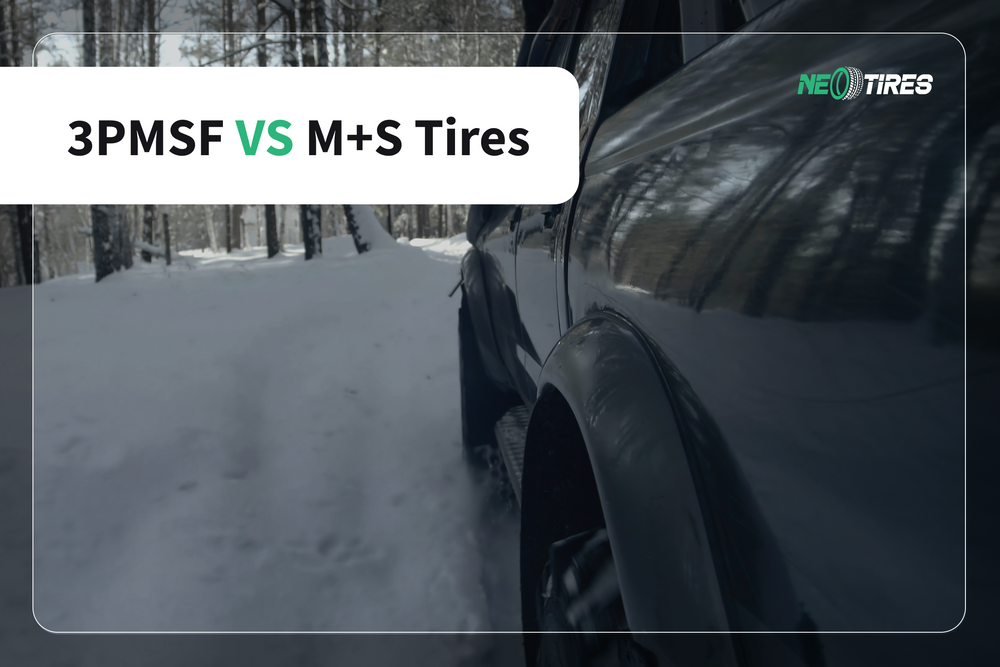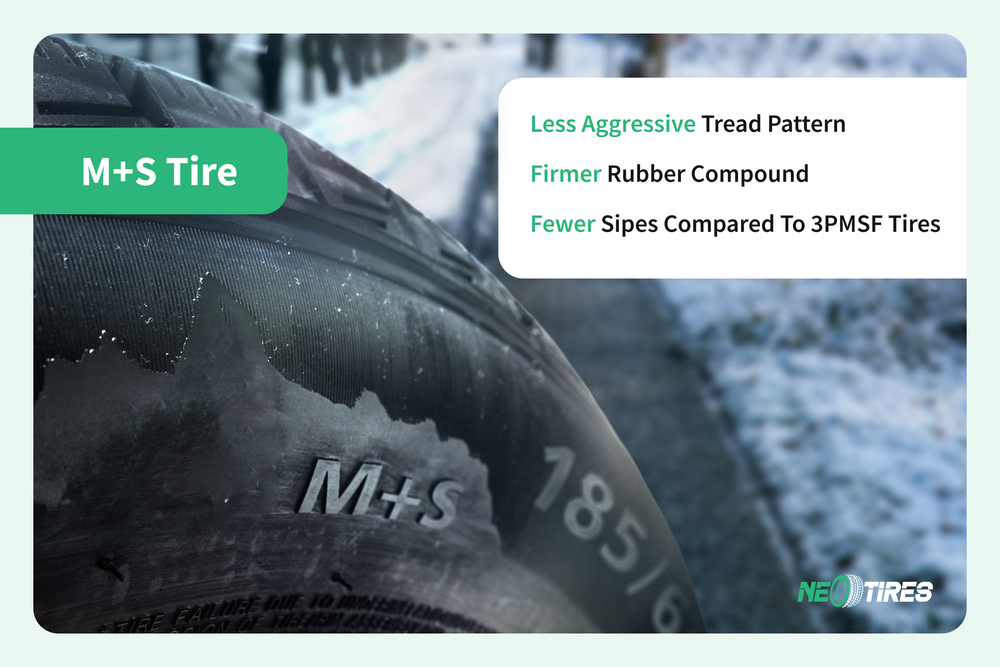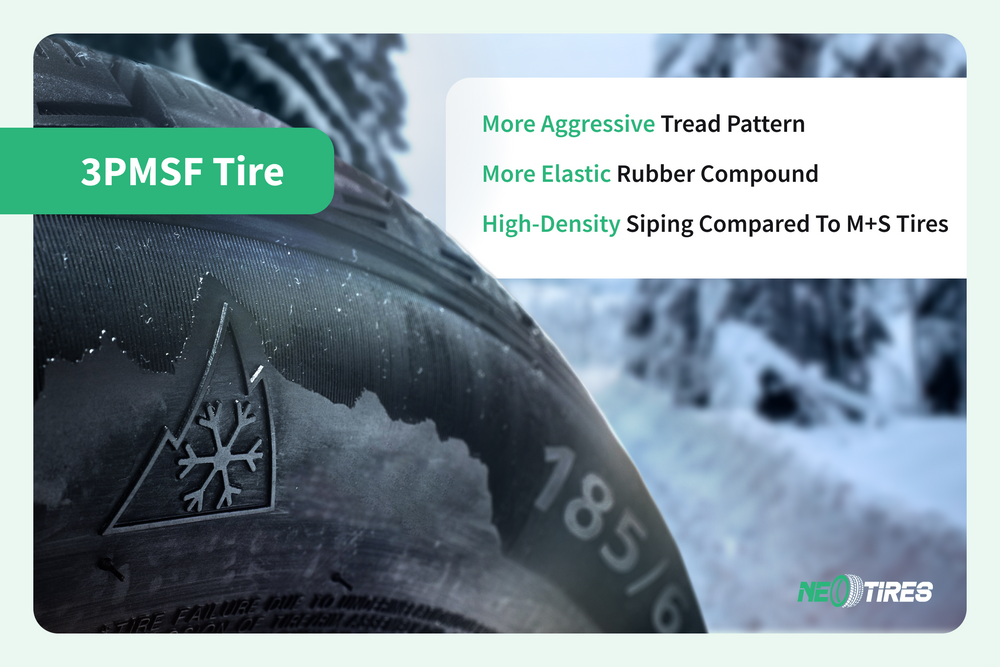Three-Peak Mountain Snowflake and M+S tire markings are about the weather conditions in which the tires perform the best. While the UTQG rating mainly talks about traction, temperature, and service life, the 3PMSF and M+S markings are about weather versatility. With this introductory note, let's delve deeper into this topic. By the end of today's article, we hope you will become a real pro in the field.
What Does the M+S Mean on All-Season Tires?
The M+S marking on a tire refers to Mud and snow performance. All-season MS tires are specifically designed to deal with wet and dry conditions, light snow, and light mud. They typically feature wide grooves, which are purposefully designed to throw mud and snow from the tire channels, facilitating traction.
MS tires do not perform well in heavy snow because their tread lacks biting edges. Instead, biting edges are present in all-weather and winter tires. Thanks to them, winter tires "bite" the ice or snow block efficiently, providing superb traction in harsh winter conditions.
Are MS Tires Good For Winter?
MS tires are good for light winter with temperatures around 46 °F (7 °C). All-season MS tires become rigid at low temperatures and don't have a specialized tread design to cope with heavy snow and ice. These tires do provide better traction than summer tires in slush and light snow. Yet, you should not expect superior performance in severe winter conditions.
3PMSF-rated winter tires are a wiser option for proper winter performance with freezing temperatures and heavy snow. Specialized winter tires grip and cut through snow blocks and ice much better than MS tires. So, it all comes down to what winter you experience in the area you live. MS tires are enough for mild winters only; heavy winter conditions require winter or all-weather tires for safety and performance reasons.
What Does the Snowflake Symbol on a Tire Mean?
The Snowflake symbol on tire sidewalls indicates the tire's performance and resistance to winter conditions. The 3PMSF marking is typically specific to winter tires manufactured with specific compounds and designs that provide superior winter traction, grip, and control in snow and ice.
What makes 3MPSF tires stand out in harsh winters? It's all about the flexible compounds at low temperatures below zero—the more flexible the tire, the higher the traction and grip.
Three Mountain Peak Snowflake tires are rigorously tested and certified to meet the highest winter performance standards. As such, a tire with the 3PMSF marking is proof of winter reliability and the maximum performance a tire can deliver.
Is 3PMSF Better Than M+S?
3PMSF tires are more reliable regarding snow traction, ice bite, and resistance to cold than MS (Mud+Snow) tires. Yet, MS tires perform dependably in light winter conditions where severe snow and ice are uncommon, and the temperature does not go much below +/—46 °F.
Consider the table below to understand the key differences better and make the right choice between 3PMSF and M+S tires:
| Feature | M+S Tires | 3PMSF (Winter) Tires |
|---|---|---|
| Winter Certification | No official winter rating | Three-Peak Mountain Snowflake (3PMSF) certified |
| Cold Weather Performance | Rigidity increases with temperature drop | Stay flexible in extreme conditions |
| Snow & Ice Grip | Better than summer tires, but not optimized for deep snow and ice | Specialized design & rubber for snow biting and control on ice |
| Tread Design | Wider grooves for water, mud/slush & light snow | Deep sipes & biting edges for grip |
| Recommended for: | Occasional winter use, slush & mud | Harsh winter conditions, ice & deep snow |
What is the difference between M+S and 3 Peak tires (3PMSF)?
Bottom Line
To sum up, M+S tires are suitable for mild winter conditions. All season MS tires aim to ensure performance in light snow and mud/slush. On the other hand, extreme temperatures make M+S tires rigid, which impacts performance and traction. 3 Peak Mountain Snowflake tires are a better solution for harsh winters with deep snow ad ice.
3PMSF VS M+S Tires: FAQs
What Does 3PMSF Mean On a Tire?
3PMSF stands for the Three Peak Mountain Snowflake Symbol, which indicates that the tire is fully prepared for severe winter conditions. A tire with a 3PMSF symbol on its sidewall has an elastic formula that ensures reliable traction even at extreme temperatures. The USTMA, a national trade association for tire manufacturers, assigns this symbol to tires.
Can I Use 3PMSF In the Summer?
3PMSF winter tires should not be used in summer. Their tread compounds and design are not optimized for stability on hot and dry roads. 3PMSF all-weather tires can be an alternative for year-round use, including summer. Yet, consider the trade-offs of using all-weather tires in summer as they:
- wear faster due to softer compound
- provide higher rolling resistance compared to summer/all-season tires
The best practice is switching to summer or all-season tires when temperatures exceed 46 °F for optimal longevity, fuel efficiency, and ad performance.
Are M+S Tires All Season?
Yes, the M+S symbol is found on most all-season tires. This means the tire delivers optimal performance in muddy/slushy and snowy conditions whenever snow does not fall more than just a few inches. It's worth mentioning that there is no actual accreditation or testing for a tire to get the M+S label. In contrast, a tire featuring the 3PMSF symbol is subject to specialized testing and accreditation.
Not Sure Between 3PMSF or M+S Tires?
NeoTires is just a few clicks away to guide you. Contact our experts to help you choose between 3PMSF and MS tires to ensure optimal driving performance. If you already know what you need, explore our tire catalog to find the best-rated models at optimal prices. Drive safe and choose your tires wisely!







